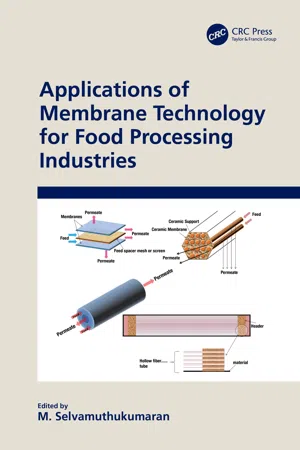
- 260 pages
- English
- ePUB (mobile friendly)
- Available on iOS & Android
Applications of Membrane Technology for Food Processing Industries
About this book
Membranes processing techniques are used to help separate chemical components based on molecular size under specific pressure. A great advantage of membrane processing techniques is that it is a non-thermal processing technique, which can retain enormous bioactive constituents to a greater extent. Being a less energy intensive process, this technique is widely used in several food processing industries such as in the clarification of fruit juices and wine; the concentration of milk; the preparation of whey protein concentrate; and water and waste treatment, among others.
Applications of Membrane Technology for Food Processing Industries introduces membrane processing techniques, presenting principles, theory and operational conditions for achieving efficient quality product. It discusses different types of membrane processing techniques viz. reverse osmosis, nanofiltration, ultrafiltration, electro dialysis, microfiltration, pervaporation, including its applications, advantages and disadvantages.
Key Features:
-
- Deals with the retention of antioxidants by using novel membrane processing techniques
-
- Includes the application of membrane processing techniques in whey processing
-
- Explains the method for degumming, dewaxing and decolorization of edible crude oils
-
- Narrates application of membrane processing techniques in waste water treatment for efficient use
Readers, such as professors, scientist, research scholars, students and industrial personnel, will come to know about the current trends in use of membrane processing techniques for its application in several food processing industries. This book can be a ready reference for the food industrial industry for manufacturing of deacidified clarified fruit juices and wine by using integrated membrane technique approach.
In a nutshell, this book will benefit food scientist, academicians, students and food industrial persons by providing in-depth knowledge about membrane processing of foods for quality retention and also for efficient consumer acceptability.
Frequently asked questions
- Essential is ideal for learners and professionals who enjoy exploring a wide range of subjects. Access the Essential Library with 800,000+ trusted titles and best-sellers across business, personal growth, and the humanities. Includes unlimited reading time and Standard Read Aloud voice.
- Complete: Perfect for advanced learners and researchers needing full, unrestricted access. Unlock 1.4M+ books across hundreds of subjects, including academic and specialized titles. The Complete Plan also includes advanced features like Premium Read Aloud and Research Assistant.
Please note we cannot support devices running on iOS 13 and Android 7 or earlier. Learn more about using the app.
Information
1
Introduction to Membrane Processing
ABBREVIATIONS
| CA | cellulose acetate |
| ED | electrodialysis |
| FO | forward osmosis |
| GS | gas separation |
| LM | liquid membrane |
| MBR | membrane bioreactor |
| MD | membrane distillation |
| MF | microfiltration |
| NF | nanofiltration |
| PV | pervaporation |
| RO | reverse osmosis |
| UF | ultrafiltration |
1.1 Introduction
1.2 Historical Overview of Membrane Technology
1.3 Operating Principle of Membrane Separation
Table of contents
- Cover
- Half-Title
- Title
- Copyright
- Dedication
- Contents
- Preface
- About the Editor
- Contributors
- 1 Introduction to Membrane Processing
- 2 Frequently Used Membrane Processing Techniques for Food Manufacturing Industries
- 3 Theoretical Approach behind Membrane Processing Techniques
- 4 Deacidification of Fruit Juices by Electrodialysis Techniques
- 5 Clarification of Fruit Juices and Wine Using Membrane Processing Techniques
- 6 Microfiltration Techniques: Introduction, Engineering Aspects, Maintenance, and Its Application in Dairy Industries
- 7 Applications of Membrane Technology in Whey Processing
- 8 Membrane Technology for Degumming, Dewaxing and Decolorization of Crude Oil
- 9 Retention of Antioxidants by Using Novel Membrane Processing Technique
- 10 Application of Membrane Processing Techniques in Wastewater Treatment for Food Industry
- Index